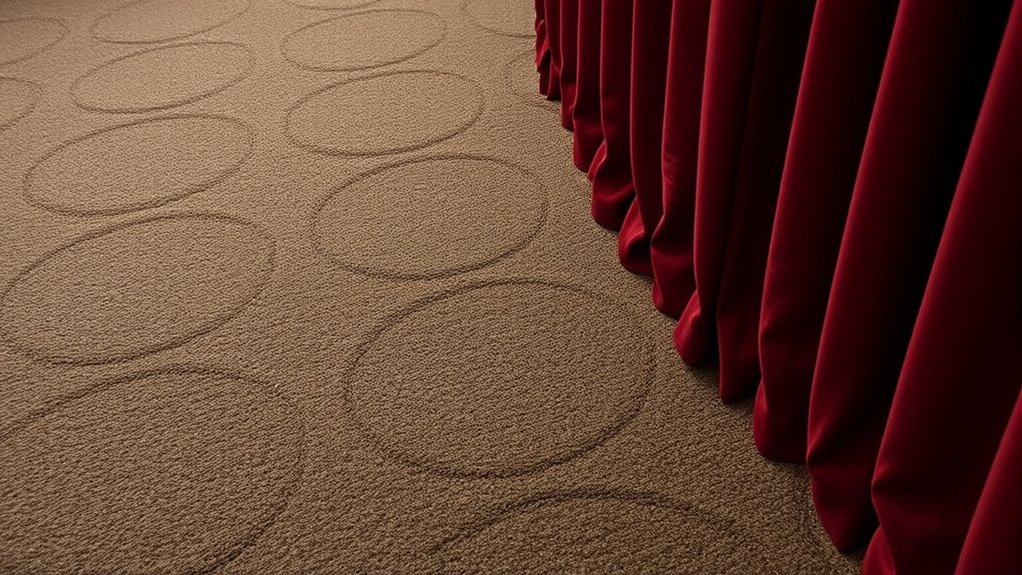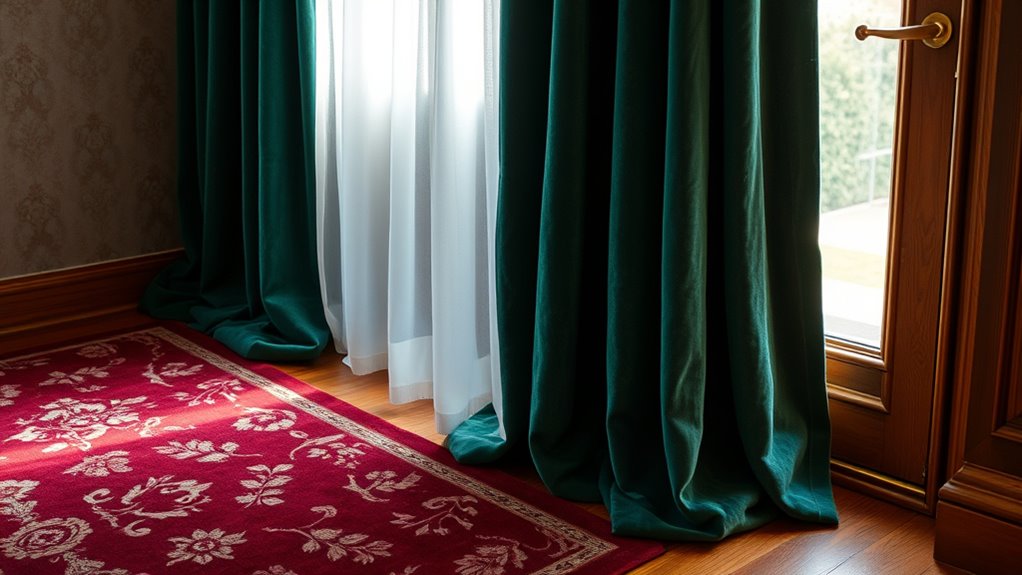To improve sound control, choose plush carpets made of wool or dense synthetics and pair them with heavy curtains like velvet or blackout fabrics. Layer curtains with sheers for added sound absorption while letting in natural light. Ensuring proper placement and coverage maximizes effectiveness. Coordinating colors and textures creates a cozy look while reducing noise. If you want to learn how to optimize your space further, keep exploring options that suit your style and needs.
Key Takeaways
- Use thick, plush carpets made from wool or dense synthetics for effective sound absorption.
- Choose heavy, dense fabrics like velvet or blackout curtains to block sound and enhance dampening.
- Layer curtains with sheers underneath heavier drapes to improve sound absorption while maintaining light.
- Properly size and position carpets and curtains to maximize coverage and sound dampening in the room.
- Coordinate colors and textures of carpets and curtains to achieve both aesthetic harmony and functional sound control.

Are you unsure how to choose the perfect carpet and curtains for your space? When it comes to creating a comfortable environment, especially one with ideal sound quality, the right combination of these elements makes a significant difference. Your goal is to improve sound absorption while maintaining aesthetic coordination, so every piece works together seamlessly. First, consider the type of sound you want to control. If noise reduction is a priority, thick, plush carpets are excellent because they absorb sound waves effectively, reducing echo and background noise. Opt for materials like wool or dense synthetics, which are known for their superior sound absorption qualities. Pairing a plush carpet with long, heavy curtains can further dampen sound, especially in rooms prone to echoes or external noise. When selecting curtains, look for dense fabrics like velvet or thick blackout materials—they don’t just block light but also absorb sound, creating a quieter space. The key is to choose curtains that complement your carpet in both function and style. Aesthetically, coordination is essential. You want your carpet and curtains to blend harmoniously with your overall decor, not clash or appear mismatched. Pick a color palette that reflects your taste while ensuring the textures and patterns complement each other. For instance, if your carpet has a bold pattern, consider solid-colored curtains to balance the visual weight. Conversely, if your carpet is neutral, adding curtains with subtle patterns or textures can bring depth without overwhelming the space. Texture plays a critical role in aesthetic coordination as well. Combining the plushness of a thick carpet with the soft drape of velvet curtains creates a cozy, inviting atmosphere. You might also consider layering curtains—sheer curtains underneath heavier drapes—to enhance sound absorption without sacrificing natural light or style. Don’t forget to think about the room’s purpose and your personal preferences. A home theater or music room benefits from more substantial sound-absorbing materials, while a living room might strike a balance between sound control and a lively ambiance. Finally, pay attention to the size and placement of your carpet and curtains. Properly fitting these elements ensures maximum coverage and effectiveness in sound dampening. Hanging curtains close to the ceiling and extending beyond window frames can improve sound absorption and aesthetic appeal. Overall, choosing a combination that aligns with your functional needs and visual preferences results in a space that’s not only quieter but also stylishly cohesive. With thoughtful selection, your carpet and curtains can transform your room into a peaceful, beautiful sanctuary.
Frequently Asked Questions
How Do I Measure My Space for Optimal Sound Absorption?
To measure your space for ideal sound absorption, start by noting the room dimensions—length, width, and height. Use a tape measure or laser distance meter for accuracy. Then, take acoustic measurements if possible, like reverberation time or sound level readings, to identify problem areas. These measurements help you determine where to place carpets and curtains effectively, ensuring maximum sound absorption and improved acoustics in your space.
Are There Eco-Friendly Carpet and Curtain Options Available?
Yes, eco-friendly carpet and curtain options are available. You can choose products made from recycled fibers, which reduce waste and promote sustainability. Organic materials like hemp, bamboo, and organic cotton are also popular, offering natural sound absorption while being environmentally friendly. These options not only help you create a greener space but also contribute to better indoor air quality, making your environment healthier and more sustainable.
Can I Combine Different Materials for Better Soundproofing?
Yes, you can combine different materials for better soundproofing. Studies show that layering diverse materials can reduce sound transmission by up to 60%. By mixing materials like thick carpets with dense curtains, you enhance sound absorption through effective design integration. This technique not only improves acoustic performance but also adds visual interest. Experimenting with material mixing allows you to customize your space’s soundproofing while maintaining your aesthetic preferences.
How Often Should Carpets and Curtains Be Replaced for Sound Quality?
You should replace carpets and curtains every 5 to 10 years, depending on their lifespan of textiles and your maintenance routines. Regular vacuuming, cleaning, and prompt repairs help prolong their soundproofing effectiveness. If you notice significant wear, fading, or a decline in sound absorption, it’s time for replacements. Maintaining your textiles properly guarantees they continue to contribute effectively to your space’s sound quality and overall comfort.
Do Certain Colors or Patterns Enhance Sound Absorption?
You might notice that darker, muted colors like navy or charcoal, influenced by color psychology, often enhance sound absorption by creating a cozy, absorbing environment. Patterns such as irregular or textured designs disrupt sound waves more effectively than plain fabrics. For example, a room with patterned curtains might reduce echo better than solid, light-colored ones. Choosing colors and patterns thoughtfully can considerably improve your space’s sound quality.
Conclusion
By choosing the right carpets and curtains, you create a cozy haven that muffles noise and boosts comfort. Think of your room as a chamber of secrets, where plush fabrics act like medieval tapestries, soaking up sound like a sponge. Remember, the right selections turn your space into a sanctuary, making it feel like you’ve stepped into a quiet library, even amid the hustle and bustle of modern life. Your perfect acoustic retreat is just a fabric away.















